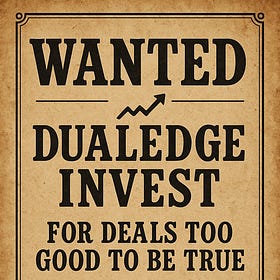Last week, we had to shift our plans a little bit. Instead of screening for viable companies and picking one to fully analyze, I opted for two deep-dives. One on Equinix and one on Digital Realty Trust (DRT), two giants in the world of data centers.
In that same article, I tried to highlight a bit what to look for when valuing a REIT. The trigger? A (rejected) bid on a Belgian REIT I currently own. Under the motto of “the grass is always greener on the other side”, the search for a decent investment started, if necessary, of course. Well, as it turns out this wasn’t a waste of time: as of Tuesday, the offer has been accepted. This leaves two options: receiving shares of the acquiring REIT, or get out and look for a better alternative.
Exactly the goal of today.
Today, I’ll be tackling the second data center REIT on the list: DRT. So, without further ado, let’s dive in. Grab yourself a coffee, sit back, and dive with me in the numbers of Digital Realty Trust!
Digital Realty Trust - The Numbers
FFO = Net Income + Depreciation & Amortization - Gains on Sale of Assets
The Funds From Operations (FFO) for DRT have been growing over the past three years, a good sign! The growth rates for 2024 and 2023 were 5,8% and 5,3%, respectively. This could be an indication that DRT becomes steadily more efficient, or it could of course be pure luck. For now, let’s assume that this is a great indication.
AFFO = FFO – Capital Expenditures – Straight-lined Rent Adjustments
AFFO - 2024 = $64,502,000 - per share: $0.19
AFFO - 2023 = $749,705,000
AFFO - 2022 = -$2,944,962,000
The Adjusted Funds From Operations (AFFO) - the potential dividend a REIT could pay out - is a different story. Keep in mind, however, that these are calculated based on the numbers from the cash flow statements as DRT didn’t explicitly mention the AFFO. In 2024, the AFFO per share only reached $0.19, implying a potential dividend yield of 0.11% at the current market price of $172.23.
Yup, not exactly thrilling.
In 2022, the AFFO even became negative, and a lot. The main reasons for this? Acquisitions and a low gain from selling assets. Therefore, it can be useful to calculate the Adjusted Adjusted - yes, twice - FFO. For these calculations, the cash spent on acquisitions is left out of the equation. The result for the “AAFFO” is as follows:
AFFO - 2024 = $572,503,000 - per share: $1.70
AFFO - 2023 = $802,002,000
AFFO - 2022 = -$1,014,784,000
Better. But nothing exciting either. For 2024, the (adjusted) potential dividend yield barely reached a 1%. As always, the truth is somewhere in the middle. Acquisitions are costly today, but can be excellent assets, and therefore good investments which may justify the lower yields today.
From this perspective, the full amount of acquisitions might be quite an overstatement when calculating the “normalized” future investment needs. On the other hand, acquisitions are inherently a part of the growth strategy. Therefore, ignoring acquisitions because they don’t represent the normalized future investments needs might be a significant understatement.
A dual-edged sword, indeed.
NAV = (Market Value of Assets – Liabilities) / Total Outstanding Shares
NAV per share - 2024 = $68.84
NAV per share - 2023 = $73.16
The NAV is calculated - just as with Equinix - based on the book value of assets rather than the market value. Not just to try something fancy, but simply because the market values were not available. It’s safe to assume that the market value of assets will be higher - even if the market value stays the same, the asset value declines due to depreciation. Therefore, take this as a very conservative estimate of the NAV.
In 2023, NAV amounted to $68.84 per share. At market price, this implies that investors receive $68.84 worth of assets for a price of $172.23, or pay a steep premium of 150%. For context, Equinix trades at an even higher premium with a similar NAV, reinforcing how much of the sector’s value is based on future cash flow potential. Investors here aren’t buying assets - they’re buying growth.
The Numbers
Let’s look at the quantitative comparison first.
Equinix clearly scores better in generating cash efficiently. The AFFO has been growing steadily over the last couple of years with a strong CAGR of 11%. The dividend yield is higher as well - standing at about 4% - even when the stock price is about 5 times higher. Quite steady all-around.
It seems like the market is really appreciating this too. At a very high premium of over 10-fold, this steady cash flow character seems priced in already. Compared with the 150% premium for DRT, Equinix seems to heavily overpriced for what it offers.
On the other hand, the lower premium paid for DRT seems justified when looking at the volatile AFFO. Heavy investments and an acquisition strategy have burned a lot of cash over the last three years. Although these investments could bear a lot of fruit later on, the lack of stability makes DRT a much riskier investment. This, in turn, is partially reflected in the lower premium.
The Story
Normally, I’d try to build the story first. That way, I’m much less biased to look for certain things I expect from the numbers. Because - as mentioned in Part I - this series started a little different than I hoped, the story comes after the numbers. A first for me too.
Anyway, let’s dive into the key qualitative differences between REITs. I’ll keep it to the major ones—no need to turn this into the next Bible. But hey, if you're up for it, the annual report is all yours. Who knows, maybe you'll spot something that the market missed.
CORPORATE STRUCTURE
Let’s start with how the two companies are set up. DRT uses a more layered structure, where one entity controls another that owns the actual data centers. Equinix keeps it simpler, operating more directly through its main REIT structure. While there are technical differences behind the scenes, what matters most is how those choices show up in strategy, customer focus, and revenue. We’ll see those differences play out in the next sections.
DATA CENTER TYPE
The biggest qualitative difference? The data center types. DRT focuses more on hyperscale customers, while Equinix uses a colocation and interconnection model. If this sounds like Chinese to you, make sure to check out this article. The difference in these business models results in important qualitative differences. These ultimately result in a difference in numbers, as explained.
First of all, the level of customer diversification is very different. DRT attracts higher-profile customers but has fewer, while the opposite is true for Equinix. This is reflected in the revenue diversification. At Equinix, none of the customers contribute to at least 10% of the revenue, while DRT has one customer accounting for 12% of revenues. Different business models, different customers, and in turn a different composition of the revenues.
In one of the previous parts, a few trends were highlighted, such as AI and Cloud Computing. Due to the differences in business models, both REITs are implicitly focusing on different trends.
In the case of DRT, Cloud Computing should be the future. Lots of demand for cloud space at their high-profile customers such as Amazon and Google. The result is large facilities filled with data servers.
Equinix, on the other hand, targets interconnection. Their goal is to build “hubs” of data centers and a platform for digital ecosystems. Smaller data centers, but fueled by the revenues of services, and the efficiency of interconnection. It’s these differences in revenue composition - service revenues versus rental revenues - that result in a difference in corporate structure. Equinix needs its TRS structure for service revenues, while their TRS structures qualify for a tax-friendly treatment, coming from rental revenues.
GEOGRAPHY
Different business models lead to differences in where these companies operate. Equinix has a much more widespread base for its data centers, while DRT is much more focused in the US. Again, these different approaches result in different corporate structures. DRT operates according to a more US-based model, while Equinix takes a more global approach.
CAPITAL ALLOCATION
Finally, there’s a difference in capital allocation. Equinix focuses much more on customer experience - a must when focusing on multiple smaller customers. The result is a much more steady, organic growth. DRT, on the other hand, only has a handful of customers that need space. And a lot. Hence, their approach is focused on scaling up as much as possible. The result? Acquiring a lot of smaller businesses to grow infrastructure.
In closing, DRT and Equinix show how strategy shapes everything — from cash flows to customer mix. While DRT’s heavy investments may pay off long-term, they come at the cost of short-term predictability. Equinix’s steady growth and broad customer base offer more stability, but at a steep valuation. As always, it’s a balance between today’s fundamentals and tomorrow’s potential. The choice depends on what kind of investor you are.
Final Remarks
To wrap things up, we took a deep dive into Digital Realty Trust (DRT) this week, following our earlier look at Equinix. While both are major players in the data center REIT space, their numbers and strategies tell very different stories. DRT’s capital-intensive growth strategy has weighed on its short-term performance, particularly in terms of AFFO and dividend yield, but could set the stage for long-term gains. The corporate structure, customer base, and revenue models all differ sharply from Equinix, highlighting how business models shape financial results. As always, it’s a delicate balance between today’s metrics and tomorrow’s potential.
Now that the bid on the Belgian REIT I own has officially been accepted, we’ll soon dive into a piece on that one too—stay tuned for a breakdown of what’s next for that investment.
Until then, enjoy the rest of your week!
📢 What do you think? Equinix, Digital Realty Trust or neither? Let us know in the comments!
🔔 Make sure to subscribe if you want more of our content directly in your inbox while it’s still free!
Please note: This article includes a disclaimer regarding investment advice.
Our Recent Posts
A Permian Water Company with Oil-Tier Risks. Here’s Our Deep Dive.
Yesterday, we hinted. Today, we deliver.
You Don't Want To Miss This Deal
Today’s post is a little different. Because today marks a turning point in the DualEdge Invest story.
The Value In Real Estate
Recently, we wrote an article which covered the opportunities in data. We discussed how AI and Cloud Computing could be major drivers for data center growth. There was, however, one important catalysator: Moore’s Law. Or rather, the lack thereof. I will not repeat myself too much — so if you’re interested, make sure to go check out our previous article …







